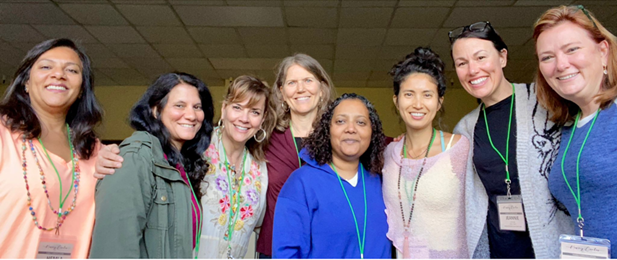Goddesses of the Waters: Embodying the Intuitive Mysteries of the Aquatic Realms
- Hemla Makan-Dullabh
- Feb 28, 2024
- 4 min read
Water goddesses across various cultures embody the essence of life, emotions, and the natural world. They remind us of the purity, preciousness, and nurturing aspects of water—the life-giver. It is also in the watery realms that our unconscious has the potential to transform and become conscious. In this blog, we will meet eight water goddesses, each symbolizing divinity, love, and femininity in their unique ways. The invitation is for you to notice what is coming up for healing or recognition from your unconscious into the conscious. If you don't know, you can call upon the goddesses to guide you.
Mami Wata: The African Spirit of Water

Mami Wata is a powerful water spirit that originates in African mythology and embodies the waters' mysteries and wealth. Mami Wata is a collective of water spirits who all honor the sacred nature of water. She is often depicted as a mermaid or a beautiful woman. Mami Wata is worshipped by many for her abilities to heal, provide wealth, and protect her followers. She embodies polar opposite energies and expresses this possibility that lies in our unconscious, a place of the unknown and a myriad of possible emotions. If you dream of water, oceans, or seas notice if the water is clear or murky, filled with sea life, or empty. These offer us insights into the unconscious and the possibilities that lie there. See if you keep a dream journal and if your dreams reveal a story or pattern of behavior for you to recognize and work with.
Oshun: The Yoruba Goddess of Rivers

Oshun is revered in the Yoruba religion as the goddess of rivers and fresh waters, symbolizing fertility, love, and beauty. She is often depicted as a benevolent and generous deity, offering assistance to those in need and bringing them prosperity and happiness. Oshun is celebrated for her wisdom, healing powers, and ability to bring joy and pleasure into people's lives.
Call upon Oshun to remind you to practice loving kindness to yourself and others.
Persephone: The Greek Goddess

While primarily known as the queen of the underworld, Persephone has connections to the life-giving cycle of water through her story of death and rebirth. Her annual descent into and return from the underworld symbolizes the seasonal cycle of growth and decay, which includes the rains that replenish the earth each spring.
When we apply this same concept to ourselves we go through cycles of connecting with the shadow aspects of ourselves (underworld) and the light aspects of ourselves in the conscious world. We can call upon Persephone to guide us, especially when we are working on bringing things from our unconscious shadow aspect to the conscious light so that we can see it and work through it.
Yemaya: Goddess of the Sea

Yemaya, known as the Mother of All, originated in the Yoruba religion and found a new home in South America through the diaspora. In Brazil, she is celebrated as Iemanjá, a powerful deity of the sea who offers protection, healing, and motherly love to her followers. Yemaya is revered for her immense capacity for kindness and compassion, helping people to heal from emotional wounds.
Amphitrite: The Greek Goddess of the Sea

Amphitrite, in Greek mythology, is the goddess of the sea and the wife of Poseidon. She represents the calm and bounty of the ocean, ruling over marine life, and is often depicted riding a chariot pulled by sea creatures. Her gentle nature is a reminder of the sea's nurturing and life-sustaining properties.
Water has healing and nurturing properties. Our bodies are over sixty per cent water, so what we say to ourselves gets stored in our bodies and the memory of the water within our bodies. The body is nurtured when we practice saying loving words and inviting loving thoughts about ourselves into our bodies. Emoto Maseru speaks about our words' impact on water, so think about how your words impact your body.
Sedna: The Inuit Goddess of the Sea

Sedna is a central figure in Inuit mythology, reigning over the marine animals and the underworld. Her story is of betrayal and transformation and highlights the Inuit people's respect and reverence for the sea and its creatures. Sedna teaches the importance of harmony and balance in human interactions with the natural world.
Tiamat: The Mesopotamian Goddess of the Sea

Tiamat is a primordial goddess in Mesopotamian mythology, embodying the chaos of primordial creation. She represents the saltwater ocean and is often depicted as a dragon or sea serpent. Tiamat's story involves themes of creation, conflict, and the emergence of order from chaos. Our own lives have themes of order, chaos, order and chaos. We can see it as expansion and contraction; we need both to grow and learn.
Namaka: The Hawaiian Goddess of the Sea

Namaka is a Hawaiian sea goddess known for her power over the ocean and its creatures. As the sister of Pele, the goddess of volcanoes and fire, Namaka represents the opposing yet complementary forces of creation and destruction in nature. Her domain over the sea reflects the Hawaiian respect for and understanding of the ocean's vital role in sustaining life.
Our generated images are intended as a source of inspiration and conceptual exploration, crafted carefully to avoid offence.




Comments